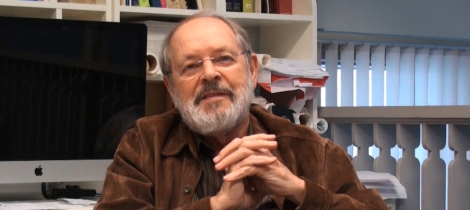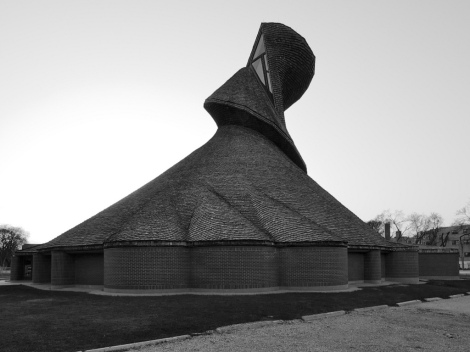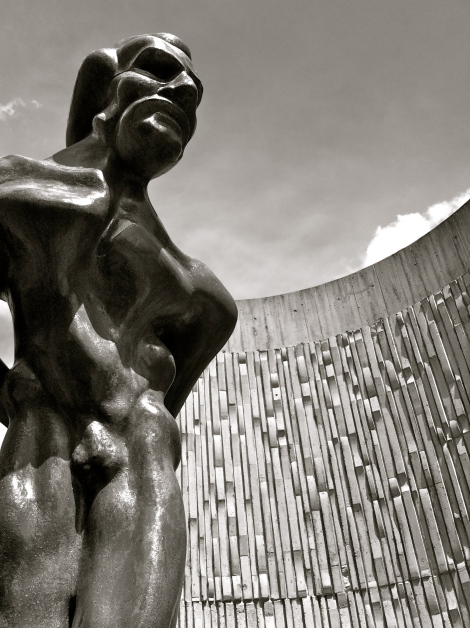
Architect Étienne Gaboury (Image source)
There are only a few 20th-century prairie architects whose resumes and impact can match those of Winnipeg’s Étienne Gaboury (according to Harold Kalman, this list would also include Clifford Wiens in Saskatchewan and Peter Hemingway and Douglas Cardinal in Alberta). (1) In the words of Brent Bellamy of Number Ten Architectural Group, “he was the shining light in the darkness of the thirty years of the 70s, 80s, and 90s, when not a lot of great architecture was happening in Winnipeg.” (2) The Winnipeg Architecture Foundation notes that Gaboury has been described as the “father of landmarks,” “Mr. Church,” “an architect as an artist” and “Manitoba’s greatest architect.” (3) His most well known projects include the Pont Provencher/Esplanade Riel pedestrian bridge, the Canadian Mint, the Canadian Embassy in Mexico, the restoration and redesign of St. Boniface Cathedral, and the Église Précieux-Sang/Precious Blood Church. Yet despite his broad recognition across the country, there is very little known about his Métis heritage.

Pont Provencher/Esplanade Riel Pedestrian Bridge, Winnipeg, Manitoba. Gaboury Préfontaine Perry Architecture Inc. Design by Guy Préfontaine & Étienne Gaboury (Image Source)
It would take hundreds of blog posts to try to somehow encapsulate Gaboury’s career, so there are some essential points to focus on here related to the current project. First, is how one’s genealogy and/or upbringing impact one’s design sensitivities, and second, what this might mean for an overall discussion of Métis design and architecture. In the case of Étienne Gaboury, these are intimately tied together. The first Gaboury (Antoine) arrived in Canada in 1690 from France, and among his descendants was Marie-Anne Gaboury who married Jean-Baptiste Lagimodiére. One of their grandchildren was Louis Riel. (4) Although this has been referred to as the essential link to Étienne’s Métis lineage given the recognizability of Marie-Anne’s name, he explains that his indigenous heritage is instead tied to his mother, Valentine Lafrenière, whose grandmother was Marie Madeline McTavish, an Ojibway from Ontario. (5) Born in 1930, Gaboury acknowledges that his family’s Métis heritage was never ‘overtly’ acknowledged growing up, as “it was considered a negative trait.” (6) For example, he recalls his grandmother Gaboury (Auriélie Chabot) constantly reminding he and his siblings that they had indigenous ancestry, and ‘berating’ them for any physical features that evidenced it (such as the black or dark brown hair and eyes of some of his siblings). As Gaboury recalls, it was not until later in life, “when being Métis became a mark of distinction, even of pride,” that his family began openly celebrating their indigenous heritage.

Église Précieux-Sang – Precious Blood Church, St. Boniface, MB (Image Source)
When asked how his identity as a Métis person has impacted his career, the expectation might be a response similar to Kalman’s description of Precious Blood church where, “The tipi provided a source of inspiration for the bold, sculptural design.” (7) But Gaboury’s answer is careful not to mistakingly simplify one’s identity or heritage with the application of formal or typological signifiers. Instead his answer reflects the rich complexity embedded in his approach to design and often attributed to the sophistication of his work.
Apart from very specific incidents that can be identified, evaluated or measured, how can one know exactly what specifically impacted one’s career? Was it the Métis factor, the French-Canadien factor, the religious factor, the cultural factor, the social factor, or the occupational factor?…The Métis trait is atavistic and primeval in that it is mostly embedded in my subconscious. Some are overt, like skin, hair and eye colour, but most are deeply ensconced in my genes whose attribution would be a minefield to unravel. My sensitivity to the environment, my respectful fascination with nature, and my love of its creatures and plants, are probably influenced by the native genealogy, at least it would have reinforced those tendencies. There is also a sense of the sacred, a more animalistic sacredness, an awe of nature, of the universe that cannot be accredited directly to my Roman Catholic upbringing since Catholicism emphasised our dominance over it rather than our belonging to it, our being an integral part of it. (8)
Thus, for Gaboury, reflections on his Métis identity lead directly to his relationship with the natural world, a connection honed through his upbringing on a Manitoban farm working long hours outdoors, caring for the various animals, and harvesting grain and hay. “I became thoroughly engrossed in nature in all its beauty, complexity, mystery, majesty,” he notes. It was not “a sensitivity,” he adds, “but an emotional attachment to it.” (9)

The plans for Église Précieux-Sang (Precious Blood Church) in St. Boniface. A move towards organicism for Gaboury, constructed in 1968. (Société historique de Saint-Boniface Archives, Fonds Étienne Gaboury) (Image Source)
It is this relationship with nature that he feels had direct impact on his architectural career, inspiring him to design in an organic way, “following a more natural and intuitive process of composition, mimicking nature where organisms evolve from the intrinsic to the extrinsic form, from the germ to its full blossoming maturity.” (10) In the case of Precious Blood, the form did not easily evolve from the tipi alone, but instead through such a lengthy organic process guided by the community. As Gaboury describes, the church had “considerable Métis cultural and social overtones…[a] fairly typical French-Canadian parish whose Métis members probably formed the majority.”(11) The priest at Precious Blood in 1965 was Father Aurèle Lemoine, O.M.I., who had spent several years as the pastor in the Métis community of Saint-Laurent. Lemoine approached Gaboury with his dream of a new church, adding that it should be, “unique, beautiful, [and] grand in scale.” (12)

Interior of Église Précieux-Sang/Precious Blood Church (Image Source)
Gaboury’s design team submitted six solutions for Precious Blood over three years, “due to the arduous search for the right solution, the proper expression.” (13) Prior to the parish purchasing additional land to specifically add more space and possibilities, the Gaboury team presented a rectangular plan to fit the site constraints while meeting their requirements, but this was rejected outright for being too ‘square’, too ‘hard’, and ‘unwelcoming’. This led to the purchase of additional land, which allowed them to develop a more resolved solution with a spiral plan, brick walls and floor, and a wood superstructure. Suggesting a Métis spatial and material identity, Gaboury further describes the design and its unanimous reception by the Métis community.
This very organic snail-inspired spiral plan with it’s teepee morphology was immediately accepted…It seems revealing, meaningful, that a group of architectural neophytes would spur an architect to seek the ‘right’ solution, one that would be meaningful to them, one that mirrored their values, their reality, one that was in harmony with their sense of space, with their subliminal, primordial memory. (14)
The appeal of the design through its attempt to reflect the community’s core values indicates, at least partially, a spatial and material manifestation of them, and further supports Gaboury’s commitment to architecture being informed by regional influences, local materials and cultures, and ‘authentic vernacular expression.’ As he writes in his essay Metaphors and Metamorphosis, “Like the meadowlarks in the fields or the loons on great lakes, our buildings should be in tune with the range of the land.” (15) Here he mentions the tipi while describing the igloo as “an organic shape par excellence.” (16) Precious Blood Church is thus an exemplary example of how a regional and organic design process can merge with the values of a community to inspire an iconic architectural expression not achievable under any other set of circumstances, which in this case was intimately tied to a Métis community.

Residence Gaboury (Image Source)
Beyond Precious Blood, Gaboury has also worked with many other Métis groups, or on projects inspired by Métis history. These include Collège Louis Riel (1968), the Louis Riel Arts and Technology Centre (1968), the Louis Riel Monument (1972, with Marcien Lemay), Louis Riel Park (1995), the Esplanade Riel crossing the Red River (2004), a Métis Interpretive Centre Study (2004), and the conceptual design for a cultural centre in Saint Laurent.

Controversial sculpture of Louis Riel by Marcien Lemay and Étienne Gaboury (concrete enclosure). Image courtesy of Winnipeg Architecture Foundation (Source).
When asked if and how working with Métis communities were distinct from others, Gaboury recalls that this depended on the project and individuals involved. For ‘most’ of the Métis he worked with, he felt their ‘métisness’ was either repressed, they didn’t know about it, or they didn’t want to know about it. (17) For those who identified strongly with their indigenous roots, Gaboury found them to have a “predilection for fluidity of space,” as well as a preference for the circle over the square, “the flowing line to the straight or angular one, open spaces to closed ones, stone to concrete, wood to steel…openness to nature, to the sun, to the sky.” (18) The level of pride in their Métis heritage also impacted their architectural preferences in his experience, with some groups preferring designs that conformed to non-indigenous norms to avoid being “noticed or singled out” in the negative sense of many indigenous people’s lived experience. Meanwhile, those who saw their Métis identity as unique and valued were, as Gaboury explains, “more amenable to expressing themselves, to reinforce their identity, and by extension, demanding that it be celebrated, reflected somehow in the resolution of a project.” (19) In the case of Saint-Laurent, the prominent Métis community located on the shores of Lake Manitoba, he designed a cultural centre that was never built due to lack of funds. However, his description of the project adds immense value to a discussion about Métis architecture.
What was fascinating about the project and the process was their firm intent to obtain an exceptional project, without compromise. They wanted a project that responded to absolutely all their needs and wishes, one that would be a beacon of who they were, a hub of the community. Their program was extensive: exhibition spaces to house the Smithsonian exhibit, a multipurpose theatre, meeting rooms, classrooms, offices, research space and facilities, eating area with kitchen, and other sundry spaces.
They selected a unique site on Lake Manitoba large enough for extensive parking, but more importantly, for expansion of the facility itself as well as the programmatic aspects of the centre. In other words, they were thinking boldly, optimistically.
In the process of evolving a solution they emphasized that the building and its amenities be fully integrated and responsive to the physical and historical character of the site, the community, the total environment. Consequently, there was special attention given to having the building be as ecologically attuned as possible, making sure that it was properly blended into the woody, aquatic landscape, built with maximum thermal efficiency and with geothermal and wind power as sources of heating, cooling and lighting.The magnificent views of the site were to be exploited; an elevated viewing deck was added, the roof of the building was landscaped for thermal efficiency but also with the intention of using it for experimental gardens, exterior activity areas and lower viewing galleries. The north, east and west walls would be built of straw bails and the south wall would open to the sun, to the view of the lake. Photovoltaic panels would be installed as well as a generating wind turbine tower.
So, while the community could not articulate expressly the architectural vocabulary, the subtleties of spacial development or of form, the thrust of their message inhered architectonic insights: genius loci, organic integration, openness with respect to the total natural spectrum, ecological sensitivity, and finally, a clear desire for a project that reflected them and their values, that would boost their pride and sense of identity. (20)
Evident here is the desire for a prominent piece of architecture to meaningfully connect with the natural surroundings while reflecting Métis values, and that this would, reiterating Gaboury’s words, ‘boost their pride and sense of identity’. Though the project was not built, the idea of supporting Métis pride and identity through well-designed architecture remains a powerful and attainable pursuit for Métis communities across the country.
Étienne Gaboury’s career has been celebrated at every level one can achieve in Canada. As an indication of this, and beyond his numerous design awards, in 2010 he received the Order of Canada and in 2012, the Order of Manitoba. He is one of the most respected and applauded Canadian architects of the 20th century. And yet most of this was achieved without public knowledge or understanding of his deep connection to his indigenous lineage. Today he speaks proudly of his Métis heritage and acknowledges that it has always played a role in shaping his identity and worldview. But he also admits that this identity has remained largely intrinsic. Could Étienne Gaboury’s career be therefore described retroactively as that of a “Métis architect”? Perhaps it should be. Aside from his expressed Métis identity and heritage, there is much in his approach to architecture and life that is consistent with the notion of a dual worldview experienced by many Métis – one outwardly grounded in the Canadian legacy of European influence and education, but also intrinsically connected to the natural and spiritual wonders of the Manitoban landscape and its indigenous stewards.
Notes
(1) Harold Kalman. 1994. A History of Canadian Architecture. Vol. 2. (Toronto: Oxford University Press). p. 818.
(3) http://www.winnipegarchitecture.ca/etienne-gaboury/
(4) http://nearvana.ca/gaboury/xsbl/proj21.html
(5) Personal Interview, March 30, 2015.
(6) Ibid.
(7) Kalman, p. 818.
(8) Personal Interview, March 30, 2015.
(9) Ibid.
(10) Ibid.
(11) Ibid.
(12) Ibid.
(13) Ibid.
(14) Ibid.
(15) Faye Hellner, ed. 2005. Étienne Gaboury (Saint-Boniface: Les Éditions du Blé). p.32.
(16) Ibid.
(17) Personal Interview, March 30, 2015.
(18) Ibid.
(19) Ibid.
(20) Ibid.

Pingback: Hidden Architecture » Precious Blood Roman Catholic Church - Hidden Architecture·